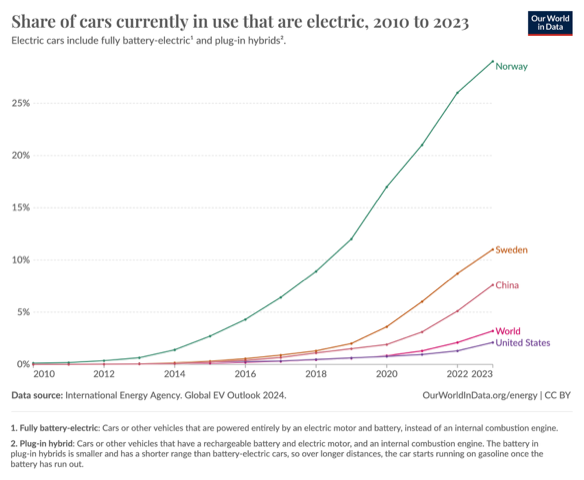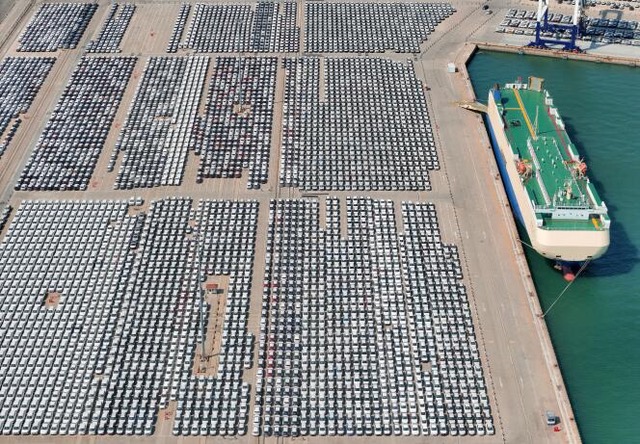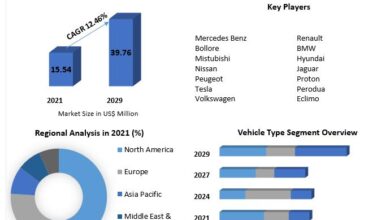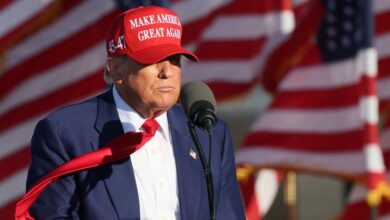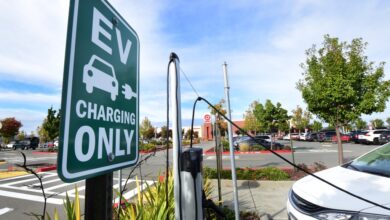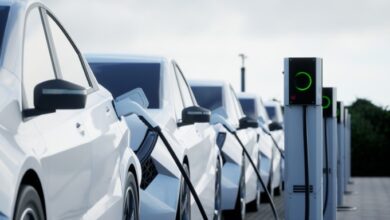On Tariffs and the EV Transition – Energy Institute Blog
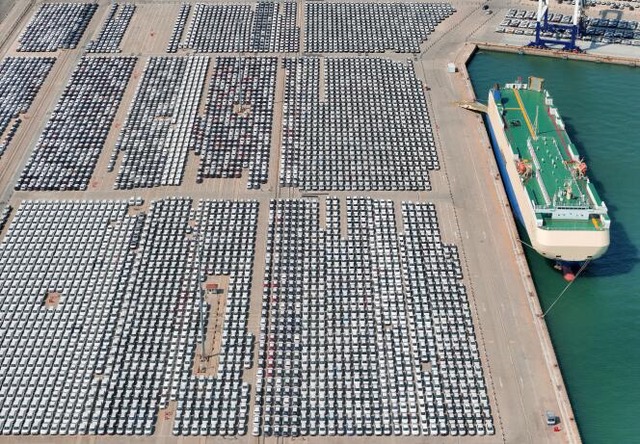
The US needs to learn to stop worrying and love the Chinese auto industry.
The Biden administration announced a bevy of new tariffs against China last week. These include a whopping 100% tariff on Chinese vehicles, as well as substantial increases in tariffs for battery components, solar cells, aluminum and steel—all of which are critical components of our decarbonization pathway, especially for the transition to electric vehicles (EVs). Can we rapidly electrify transportation without leveraging production from China?
Source: White House Press Release
There are some encouraging EV trends in the US, but the overall share of new cars that are EVs remains in the high single digits, rounding to 10% when plug-ins are included. In terms of total EVs on the road, the US lags the world average. Recent industry reports tell a story of slowdown, slower transition, and delayed product launch, and the EV market share actually fell in the first quarter of 2024. Even Tesla has wobbled of late, with a loud dismissal of the supercharger team, and disappointing earnings explained as being between two waves of demand.
Consumers continue to be deterred by the high upfront price of EVs and the slow evolution of fast charging networks, but policy is pushing in the opposite direction. The vaunted tax credits from the Inflation Reduction Act are currently available on only a dozen models because the rest have Chinese content in their battery supply chains. The new tariffs will thus raise the cost of most models currently in the US market while slowing entry of models available elsewhere that continue to rely on Chinese batteries.
—
In one view, if China wants to subsidize the global EV transition, we should celebrate, and, rather than embracing that opportunity, the new tariffs will greatly increase the degree of difficulty for a rapid EV transition in the US. China boasts four-fifths of the world’s EV battery production capacity, and more than half of the world’s electric cars are driven there. Chinese automakers like BYD, which sells credible EVs for as little as $10,000, could radically transform the US market in short order by offering EVs that appeal to a wider share of the market. Moreover, a surge in sales today could have flywheel effects by accelerating rollout of charging networks by increasing demand and giving consumers and industry greater confidence that the EV transition will indeed happen.
Source: Ward’s Automotive
It is this sort of potential for radical transformation that has created a posture of fear among the US automakers, who now openly identify Chinese competition as their biggest threat. The Biden administration’s protectionist broadside is meant to box out Chinese automakers and force firms to on-shore an increasing part of the supply chain.
There is a case to be made for this approach, which I describe next, but it certainly raises costs and slows the EV transition in the near term. There is, however, an even bigger long term risk if the US locks itself into viewing the Chinese automobile industry strictly as an adversary, instead of learning to see it as a possible resource that can be leveraged.
Bidenomics and the Logic of Tariffs
Last week’s tariffs, while shocking to many in their magnitude, were not surprising. They are perfectly consistent with the Biden administration’s broader strategy, which emphasizes supply chain resiliency and manufacturing on-shoring, while specifically keeping China out of the US market where possible.
Proponents of this approach argue that tariffs are necessary to combat government subsidies that are unfairly driving down the cost of Chinese EVs (though one must pause and note the huge global environmental benefit of China subsidizing development and export of millions of EVs) and to give US automakers time to build China-free supply chains as they ramp up EV production. The IRA creates the right incentives through domestic content requirements for EV tax credits that ratchet up over time, as well as direct subsidies for clean energy manufacturing. Advocates point to the surge in investment in US manufacturing and say that the plan is working.
But there is a risk in viewing the Chinese strictly as an adversary because the Chinese auto industry has gotten really good. Last year, BYD passed Tesla in terms of global EV sales (though they fell back behind in 2024Q1). China now exports more cars than Japan, the reigning leader for decades prior. Chinese automakers are rapidly gaining market share in Europe, now taking a quarter of the EV market there, and in other markets where they directly compete with the US, like Brazil. Last month’s Beijing auto show was abuzz with European and North American businesses seeking to form partnerships to harness Chinese advances in AI, smart-car features, and LIDAR.
Cars lined up for export from China (Source: Le Monde)
Viewing the Chinese Industry as an Asset
Given the progress of the Chinese auto industry, it makes most sense to think strategically about how it can be leveraged to accelerate progress in the US, while maintaining concern over long-run industrial development. We should be asking what we can learn from their advances in battery development, how we can benefit from global economies of scale, and where and when we should leverage available, inexpensive existing supply chains.
Administration officials are undoubtedly thinking in this way to some extent, but I have two concerns. First is simply administrative capacity and consistency. The US has limited muscle memory for how to conduct a balanced protectionist industrial development program. At present, we have DOE rulings on what defines a foreign entity of concern and IRS guidance on tax credit eligibility that are making legal judgments based on their interpretation of economic development goals. Moreover, this sort of nuanced pathway is unlikely to be robust to swings in partisan power in the White House because the parties are not, to put it mildly, aligned on the energy transition.
My second concern is that the broader anti-China sentiment that pervades Washington will manifest in entrenched policy that overshoots our interests. Exhibit A are calls from rust belt senators facing reelection that call for an outright ban of Chinese automobiles based on national security–evidently BYD and Geely are as dangerous as TikTok.
A potential positive pathway here is if all this is meant to encourage joint ventures and on-shoring of Chinese firms to North America. But, we have already seen pushback against possible collaborations, with Ford taking significant flak after announcing a major battery factory in Michigan because it will license technology from CCTL, the world’s largest battery maker. The DOE canceled a $200 million award for a Chinese battery facility. The Alliance for American Manufacturers went to DEFCON 1 in response to BYD’s plans to start building EVs in Mexico. They called Chinese production inside of NAFTA an “existential threat” and called for the US to refuse entry to those vehicles.
Haven’t We Seen This Movie Before?
Fear of cars invading our borders from across the Pacific is not entirely new. In the early 1980s, the US had a similar wave of panic that Japanese automakers, with their impossibly cheap and reliable vehicles, would wipe them off the earth. The Reagan administration reached a voluntary deal for a temporary quota on imports, which bought the US automakers time to adjust and encouraged Japanese firms to produce vehicles in the US. But the quotas lasted only a few years. As they were lifted, the US automakers grumbled loudly, but they eventually learned from, competed with, and sometimes collaborated with those firms.
We will need to achieve a similar approach towards China, and quickly, because the EV transition cannot wait. The promise of Bidenomics for the climate is that protectionism today will allow the US industry to catch up and then fiercely compete around the globe. The very real risk is that instead the current measures allow the US firms to move more slowly.
The Biden administration’s tariffs have an economic logic, but it is impossible to ignore that this comes during a presidential election cycle. Democrats and Republicans can apparently agree on nothing except their shared vitriol for China. Trump and Biden have been vying to each seem tougher than the other on China, which is clearly a winning political stance. The trouble is, we don’t need to be tougher in how we react to the Chinese automobile industry, we need to be smarter.
The Energy Institute blog will be on vacation next week. We will return with a new blog post on Monday, June 3.
—
Follow us on Bluesky and LinkedIn, as well as subscribe to our email list to keep up with future content and announcements.
Suggested citation: Sallee, James. “On Tariffs and the EV Transition” Energy Institute Blog, May 20, 2024, https://energyathaas.wordpress.com/2024/05/20/on-tariffs-and-the-ev-transition/
—
By default comments are displayed as anonymous, but if you are comfortable doing so, we encourage you to sign your comments.
Source
